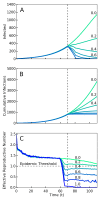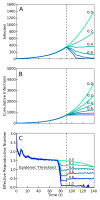Beyond Contact Tracing: Community-Based Early Detection for Ebola Response
- PMID: 27486552
- PMCID: PMC4946441
- DOI: 10.1371/currents.outbreaks.322427f4c3cc2b9c1a5b3395e7d20894
Beyond Contact Tracing: Community-Based Early Detection for Ebola Response
Abstract
Introduction: The 2014 Ebola outbreak in West Africa raised many questions about the control of infectious disease in an increasingly connected global society. Limited availability of contact information made contact tracing diffcult or impractical in combating the outbreak.
Methods: We consider the development of multi-scale public health strategies that act on individual and community levels. We simulate policies for community-level response aimed at early screening all members of a community, as well as travel restrictions to prevent inter-community transmission.
Results: Our analysis shows the policies to be effective even at a relatively low level of compliance and for a variety of local and long range contact transmission networks. In our simulations, 40% of individuals conforming to these policies is enough to stop the outbreak. Simulations with a 50% compliance rate are consistent with the case counts in Liberia during the period of rapid decline after mid September, 2014. We also find the travel restriction to be effective at reducing the risks associated with compliance substantially below the 40% level, shortening the outbreak and enabling efforts to be focused on affected areas.
Discussion: Our results suggest that the multi-scale approach can be used to further evolve public health strategy for defeating emerging epidemics.
Figures









Similar articles
-
Potential for broad-scale transmission of Ebola virus disease during the West Africa crisis: lessons for the Global Health security agenda.Infect Dis Poverty. 2017 Dec 1;6(1):159. doi: 10.1186/s40249-017-0373-4. Infect Dis Poverty. 2017. PMID: 29191243 Free PMC article.
-
Ebola virus disease outbreak; the role of field epidemiology training programme in the fight against the epidemic, Liberia, 2014.Pan Afr Med J. 2015 Oct 10;22 Suppl 1(Suppl 1):5. doi: 10.11694/pamj.supp.2015.22.1.6053. eCollection 2015. Pan Afr Med J. 2015. PMID: 26779298 Free PMC article.
-
Inflow restrictions can prevent epidemics when contact tracing efforts are effective but have limited capacity.J R Soc Interface. 2020 Sep;17(170):20200351. doi: 10.1098/rsif.2020.0351. Epub 2020 Sep 9. J R Soc Interface. 2020. PMID: 32900304 Free PMC article.
-
Role of contact tracing in containing the 2014 Ebola outbreak: a review.Afr Health Sci. 2017 Mar;17(1):225-236. doi: 10.4314/ahs.v17i1.28. Afr Health Sci. 2017. PMID: 29026397 Free PMC article. Review.
-
Travel-related control measures to contain the COVID-19 pandemic: a rapid review.Cochrane Database Syst Rev. 2020 Oct 5;10:CD013717. doi: 10.1002/14651858.CD013717. Cochrane Database Syst Rev. 2020. Update in: Cochrane Database Syst Rev. 2021 Mar 25;3:CD013717. doi: 10.1002/14651858.CD013717.pub2. PMID: 33502002 Updated.
Cited by
-
Discontinuous epidemic transition due to limited testing.Nat Commun. 2021 May 10;12(1):2586. doi: 10.1038/s41467-021-22725-9. Nat Commun. 2021. PMID: 33972522 Free PMC article.
-
The coronavirus disease (COVID-19) pandemic: simulation-based assessment of outbreak responses and postpeak strategies.Syst Dyn Rev. 2020 Jul-Sep;36(3):247-293. doi: 10.1002/sdr.1660. Epub 2020 Sep 24. Syst Dyn Rev. 2020. PMID: 33041496 Free PMC article.
-
Impact of contact tracing on COVID-19 mortality: An impact evaluation using surveillance data from Colombia.PLoS One. 2021 Mar 4;16(3):e0246987. doi: 10.1371/journal.pone.0246987. eCollection 2021. PLoS One. 2021. PMID: 33661926 Free PMC article.
-
The Ebola outbreak, 2013-2016: old lessons for new epidemics.Philos Trans R Soc Lond B Biol Sci. 2017 May 26;372(1721):20160297. doi: 10.1098/rstb.2016.0297. Philos Trans R Soc Lond B Biol Sci. 2017. PMID: 28396469 Free PMC article. Review.
References
-
- World Health Organization (WHO). Contact tracing during an outbreak of ebola virus disease. WHO. Published September 2015. Accessed February 1, 2016.
-
- World Health Organization (WHO). Frequently asked questions on ebola virus disease. WHO. Published August 2014.
-
- Tsimring LS, Huerta R. Modeling of contact tracing in social networks. Physica A: Statistical Mechanics and its Applications. 2003;325(1-2):33-39.
LinkOut - more resources
Full Text Sources
Other Literature Sources

